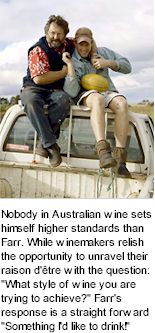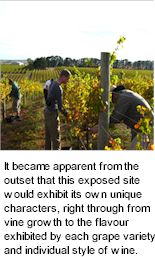


Gary was the winemaker at Bannockburn Vineyards since its inception in 1978 and gained an enviable reputation for Bannockburn Wines and more recently, his own By Farr wines. His experience as a hands-on winemaker has been enhanced by 12 vintages at Domain Dujac in Burgundy, France, and vintages in the USA at Cristom, Oregon and Calera, California. He has made numerous sojourns to other areas such as the Rhone Valley in France, where his appreciation of Shiraz and Voignier has been incorporated in his current winemaking.

Gary was introduced to winemaking through retailing when, soon after leaving school, he worked for some of Melbourne’s most prestigious wine specialists and completed the wine marketing course at Roseworthy. He joined the Yellowglen Bannockburn partnership. Not content with the results of traditional Australian winemaking techniques of the time, his true education began in 1983 when he completed his first vintage at Domaine Dujac in Burgundy.
Since then (for almost a decade) Gary had continued to follow vintage at Bannockburn with a vintage at Domaine Dujac. In 1983, he started what was to become a regular pilgrimage to Domaine Dujac in Burgundy. There he found that whilst Australian technology was superior, to gain complexity from cool grown fruit he needed to adapt to the methods used by the traditional French vignerons.
Starting with the 1984 vintage Gary applied the techniques learned in France to his pinot noir, whole bunches with stalks fermented in large, open, cylindrical stainless steel vats. The traditional process required him to plunge into the tank, immersing his body into the wine to break up the ‘hot spots’ that occurred in this uneven and ancient form of winemaking. This method, called pigeage is still practised today in production of great burgundies.

Gary's uncompromising attitude towards his vineyard and winemaking enables him to make the style of wines he likes to drink. They have attitude and a great depth of character with understated finesse. Gary Farr was Quantas/Wine Magazine Winemaker of the Year 2001 after being runner up in 2000. In 2003 he was voted equal 4th best living winemaker by his peers (The Age 28th May 2003).
Along with his son Nick (who makes his own wine under the Farr Rising Label) he has a total of 12ha in two blocks planted to pinot noir, chardonnay, viognier and shiraz - the second block of which he says "couldn't be a more perfect spot". He hankered after the 7.2ha of thinly covered limestone for 25 years but it's owner had resisted all entreaties to buy, bequeathing it to locals. When no surviving members of the family could be traced however, it was put up for auction and Farr secured what he feels will become a great vineyard.
Gary somehow managed to combine his role as chief winemaker at Bannockburn with his full-time duties on his own estate. Nick is the epitome of enthusiasm and individuality, he brings to the operation his own tastes and ideas. Nick has taken the next step as a winemaker, crafting wines which truly reflect the individual vineyard sight from which the grapes are picked. His vintages show excellent fruit, flavour and finesse. Their collaboration across a generation has produced two distinct winemaking styles that have received critical acclaim in Australia and overseas.
